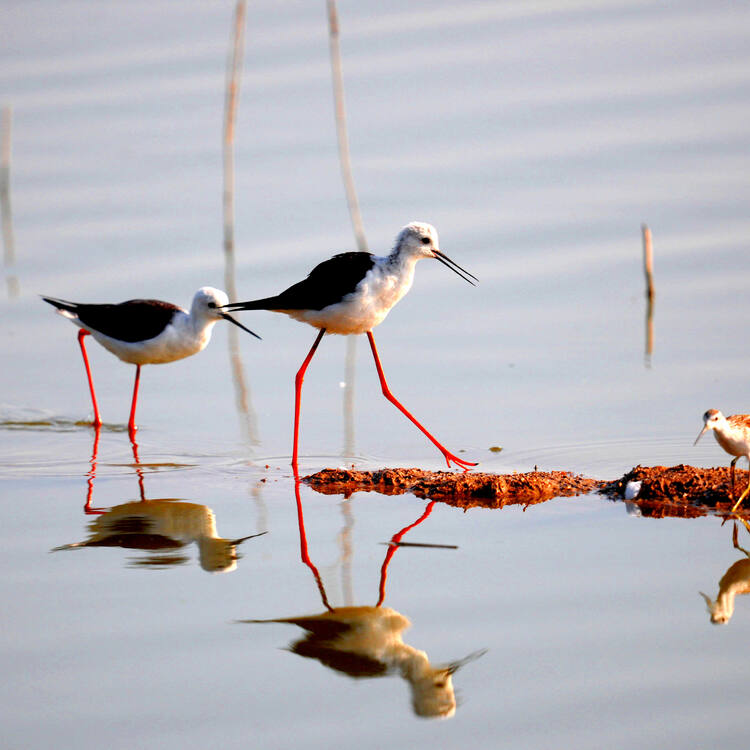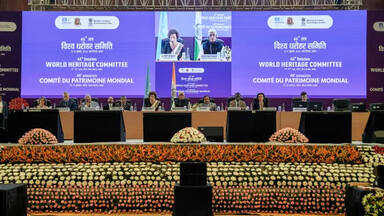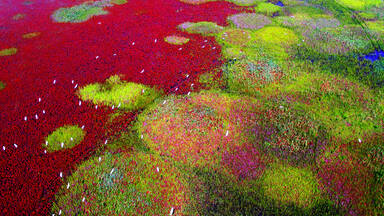Migratory Bird Sanctuaries along the Coast of Yellow Sea-Bohai Gulf of China
Migratory Bird Sanctuaries along the Coast of Yellow Sea-Bohai Gulf of China
The Migratory Bird Sanctuaries along the Coast of Yellow Sea-Bohai Gulf of China is a serial extension of the property of the same name already inscribed on the World Heritage List. As part of the world’s largest intertidal wetland system, this area within the Yellow Sea Ecoregion supports crucial habitats for birds migrating on the East Asian-Australasian Flyway which spans some 25 countries from the Arctic to South-East Asia and Australasia. The wetlands serve a unique ecological function as indispensable stopover sites for many millions of waterbirds and represent a significant example of the shared natural heritage embodied in migratory birds.
Description is available under license CC-BY-SA IGO 3.0
Sanctuaires d’oiseaux migrateurs le long du littoral de la mer Jaune et du golfe de Bohai de Chine
Les Sanctuaires d’oiseaux migrateurs le long du littoral de la mer Jaune et du golfe de Bohai de Chine sont une extension en série du bien du même nom déjà inscrit sur la Liste du patrimoine mondial. Faisant partie du plus grand système de zones humides intertidales du monde, cette zone de l’écorégion de la mer Jaune abrite des habitats essentiels pour les oiseaux migrateurs de la voie de migration Asie de l’Est-Australasie, laquelle s’étend sur quelque 25 pays, de l’Arctique à l’Asie du Sud-Est et à l’Australasie. Ces zones humides remplissent une fonction écologique unique en tant qu’aires de repos indispensables pour des millions d’oiseaux d’eau et représentent un exemple d’importance mondiale du patrimoine naturel commun incarné par les oiseaux migrateurs.
Description is available under license CC-BY-SA IGO 3.0
محميات الطيور المهاجرة على طول ساحل البحر الأصفر في خليج بوهاي الصيني (المرحلة الثانية)
يُعتبر موقع "محميات الطيور المهاجرة على طول ساحل البحر الأصفر في خليج بوهاي الصيني" توسيعاً متسلسلاً لمساحة الموقع المُدرج بالفعل تحت نفس الاسم في قائمة التراث العالمي. وتعتبر هذه المنطقة جزءاً من أكبر نظام للأراضي الرطبة الوحلية الواقعة تحت تأثير المد والجزر على مستوى العالم، وتقع داخل المنطقة الإيكولوجية للبحر الأصفر، وتساعد في الإبقاء على موائل في غاية الأهمية للطيور المهاجرة على طول مسار الهجرة من شرق آسيا وأستراليا الذي يمتد فيما يقرب من 25 بلداً امتداداً من القطب الشمالي وانتهاء بجنوب شرق آسيا وأستراليا. تؤدي الأراضي الرطبة دوراً بيئياً منقطع النظير باعتبارها محطات توقف لا غنى عنها لملايين الطيور المائية وتقّدم مثالاً هاماً على التراث الطبيعي المشترك الذي تجسده الطيور المهاجرة.
source: UNESCO/CPE
Description is available under license CC-BY-SA IGO 3.0
中国黄(渤)海候鸟栖息地(第二期)
中国黄(渤)海候鸟栖息地通过了第一期(2019年)和第二期(2024年)的分期申报程序,由十二个组成部分构成,位于世界上最大的潮间带湿地系统中,也是生物多样性最丰富的地区之一。这一自然遗产为400 多种鸟类提供了栖息地。它地处黄海生态区,是东亚-澳大利西亚迁飞通道上不可替代的枢纽,凭借其独特的生态功能成为了候鸟向北/向南迁徙过程中不可或缺的停歇地和中转站。黄海和渤海湾是数百万水鸟迁徙的咽喉瓶颈地带,占东亚-澳大利西亚航道迁徙总量的 10%以上。中国黄(渤)海候鸟栖息地是人与候鸟共享自然遗产案例中的全球典范。
source: UNESCO/CPE
Description is available under license CC-BY-SA IGO 3.0
Ареалы обитания перелетных птиц вдоль побережья Желтого моря и Бохайского залива
Этот объект является расширением одноименного серийного объекта, уже включенного в Список всемирного наследия. Являясь частью крупнейшей в мире системы приливно-отливных водно-болотных угодий, эта территория в экорегионе Желтого моря служит важнейшей средой обитания для птиц, мигрирующих по Восточно-Азиатско-Австралийскому пролетному пути, который охватывает около 25 стран от Арктики до Юго-Восточной Азии и Австралазии. Водно-болотные угодья играют уникальную экологическую роль, являясь незаменимыми местами остановки для миллионов водоплавающих птиц. Они представляют собой важный пример общего природного наследия, воплощенного в перелетных птицах.
source: UNESCO/CPE
Description is available under license CC-BY-SA IGO 3.0
Santuarios de aves migratorias en el litoral del Mar Amarillo y del Golfo de Bohai de China
El Santuario de aves migratorias en el litoral del Mar Amarillo y del Golfo Bohai de China es una extensión en serie del sitio homónimo que ya está inscrito en la Lista del Patrimonio Mundial. Esta zona, que se encuentra en la Ecorregión del Mar Amarillo, forma parte del mayor sistema de humedales intermareales del mundo. Es el sustento de hábitats fundamentales para las aves migratorias que utilizan la ruta de migración desde Asia oriental a Australasia, que se extiende por unos 25 países desde el Ártico hasta Asia Sudoriental y Australasia. Los humedales cumplen una función ecológica única como lugares de parada indispensables para millones de aves acuáticas, y representan un ejemplo significativo del patrimonio natural compartido que encarnan las aves migratorias.
source: UNESCO/CPE
Description is available under license CC-BY-SA IGO 3.0
Outstanding Universal Value
Brief synthesis
The Migratory Bird Sanctuaries along the Coast of the Yellow Sea-Bohai Gulf of China, inscribed through Phase I (2019) and Phase II (2024) of a phased nomination process, are situated in the largest intertidal wetland system in the world and one of the most biologically diverse. The property is located in the Yellow Sea Ecoregion, and supports crucial habitats for birds migrating along the East Asian-Australasian Flyway, its wetlands serving a unique ecological function as indispensable stopover and staging sites during northward/southward migration. The Yellow Sea and the Gulf of Bohai are a bottleneck for many millions of migratory waterbirds – more than 10% of the total migration along the East Asian-Australasian Flyway. The property is thus an irreplaceable and indispensable hub for birds migrating along the East Asian-Australasian Flyway, which spans not only China, Democratic People’s Republic of Korea and the Republic of Korea, within the Yellow Sea, but also some 22 countries across two hemispheres from the Arctic to South-East Asia and Australasia. The global importance of the wider coastal area is evidenced by several Ramsar sites, some of which fully or partially overlap with component parts of the property. Thus, this property is a globally significant example of the shared natural heritage embodied in migratory birds.
The twelve component parts of the property are located along the Yellow Sea coast of China, including the Bohai Gulf, with a total area of 289,710.94 ha, and a buffer zone of 117,502.10 ha. In light of the fact that human activity has transformed many of the region’s tidal wetlands, there is a need for effective measures to halt major threats and restore key migratory bird habitats, and for further national and transnational serial nominations, and/or extensions to strengthen the integrity of the property.
Criterion (x): The Migratory Bird Sanctuaries along the Coast of Yellow Sea-Bohai Gulf of China support more than 400 species of birds. The property’s tidal flats are of exceptional importance for the conservation of the world’s migratory birds, supporting internationally significant numbers of migratory bird species, including globally threatened species. The component parts of the Migratory Bird Habitat in the South of Yancheng, Jiangsu and the Migratory Bird Habitat in the North of Yancheng, Jiangsu alone are significant for more than 10% of the East Asian-Australasian Flyway populations and provide critical habitat for two of the world’s rarest migratory birds – the Spoon-billed Sandpiper and the Nordmann’s Greenshank, which depend on the tidal flats for their continued survival. The wetlands within the Migratory Bird Sanctuaries along the Coast of Yellow Sea Bohai Gulf of China serve a unique ecological function as indispensable stopover and staging sites that provide necessary food resources, ensuring fat replenishment and storage for subsequent flights during northward/southward migration. Without these important hubs, the successful migration, breeding, and population maintenance of birds in the flyway could not be maintained. In addition to providing stopover habitat for migratory birds, the component parts also include wintering areas and breeding areas for at least 45 threatened bird species including shorebirds, waterfowl, and raptors.
The property’s tidal flats also provide important migratory habitat for the threatened Black-faced Spoonbill, Oriental Stork, Red-crowned Crane and Great Knot; the Chinese Egret, Dalmatian Pelican, Swan Goose, Relict Gull and Saunders’s Gull. The property also supports further migratory bird species, including the Red Knot, Asian Dowitcher, Black-tailed Godwit, Eurasian Curlew, Reed Parrotbill, Curlew Sandpiper, Greater Sand Plover, Lesser Sand Plover and Ruddy Turnstone. Other migratory birds that utilise the property include the Eurasian Oystercatcher, Pied Avocet, Grey Plover, Kentish plover, Far Eastern Curlew, Broad-billed Sandpiper, Red-necked Stint, Sanderling, Dunlin, Terek Sandpiper, and Common Tern. The property also hosts large numbers of zoobenthos and fish species as well as important mammal, amphibian and reptile species, all part of the coastal ecosystems the migratory birds depend on.
Integrity
The property as a whole makes an indispensable contribution to the viability of the East Asian-Australasian Flyway, one of the world’s most important flyways and arguably the one most at risk and fragile. The twelve component parts of the property include clear boundaries for adequate protection of birds when they are on-site. It is, however, important to understand that the birds depend on wider coastal habitats such as reed beds and groves and hence protection and restoration efforts in these areas are equally important. The property comprises large tracts of mudflats, beaches, and other key stopover habitats for migrating birds. The intertidal mudflats, marshes and shallow waters are exceptionally productive and provide spawning and nursery habitat for many fish and crustacean species. In particular, the intertidal mudflats attract a high diversity and enormous number of resident and migratory birds. The intertidal mudflats, which have shaped the crucial habitat for migratory birds, are fed by large rivers (including the Yellow River, Yangtze River, Yalu River, Liao River, Luan River and Hai River) that provide the crucial underpinnings of this system as they continuously discharge sediments into the Yellow Sea and Bohai Gulf, accumulating to form a series of different habitat types all critical for various migratory birds.
The 2024 inscription of ten additional component parts in the Phase II extension has enhanced the integrity of the Phase I property inscribed in 2019, added over 100,000 hectares of migratory bird habitat. Nevertheless, there are further important areas that would deserve to be included in the existing series to fully meet integrity requirements. In this regard it is important to note the context provided by Decision 43 COM 8B.3 of the World Heritage Committee, which first inscribed the property in 2019. This decision was taken by the Committee on the understanding that the State Party would submit a nomination that includes all the additional components of the proposed serial listing as a whole, in order to reflect the full range of natural wealth and diversity of the ecoregion and to meet integrity requirements, supported by a comprehensive and detailed overview and analysis of priority conservation areas in the Yellow Sea and Bohai Gulf, including the fourteen additional areas identified in the original Phase I nomination, fully taking into account ecosystem and habitat diversity of the coastal system, proposed boundaries, values (including species occurrence, abundance and conservation status), threats, integrity, protection and management. Thus, the further and full implementation of this Decision of the Committee remains essential.
The entire coastline lies within a densely populated and intensively used part of China that has been subject to very substantial anthropogenic modification and impact over a long period. While human activity has transformed vast tracts of the coast and tidal wetlands, policies that promote a more ecologically sustainable society are emerging to halt the transformation of the remaining natural areas and to even reverse trends by restoring key migratory bird habitats. To add complexity, however, many of the underlying factors of change, such as pollution, oil exploration and exploitation, marine traffic, the modification of major rivers and their sediment loads, wind energy and infrastructure on land and in the sea, stem from outside the property including the coast and near-shore waters.
Protection and management requirements
The component parts of the property are state-owned and fully protected by law. Ecological Red Lines are also conducive to their conservation and effective management. These management and conservation policies provide the necessary mechanisms for maintaining intact ecosystems and biological processes within the property. Furthermore, it is essential that the buffer zones in areas adjacent to the component parts provide an added layer of protection against wider threats.
In light of the major past transformation of, and profound impacts on the coastal and intertidal ecosystems and ongoing high pressures and threats, protection measures need to be strengthened and expanded, including through the planned designation of two national parks, but also through the avoidance and mitigation of threats from outside the boundaries of the property. In this respect, China has established a series of wetland conservation policies, including the Notice of the State Council on Strengthening the Protection of Coastal Wetlands and Strictly Controlling Land Reclamation from Sea (G.F. [2018] No.24), the Notice of the General Office of the State Council on Issuing the Scheme of Wetland Protection and Restoration System (G.B.F. [2016] No.89), and the Guiding Opinions on Establishing a Nature Reserve System with National Parks as the Main Component. The Wetland Protection Law China has completely prohibited reclamation projects and actively advanced the restoration of tidal flat ecosystems in some damaged areas, representing a change from “seeking resources from nature” to “living in harmony with nature”. Under the conservation and management plan of each component part, local residents are permitted to continue traditional environmentally sustainable marine fishing, aquaculture and farming activities in the component parts.
The local governments of Shanghai, Shandong, Hebei and Liaoning have approved the establishment of leading groups and offices for the World Heritage inscription, and assigned full-time personnel for the conservation and management of the property’s component parts and buffer zones. For each component part, specific management organizations and protection teams have been established, and detailed management regulations and measures have been enacted. Tourism will be concentrated in limited designated areas, and local residents are encouraged to engage in the conservation and publicity of the component parts and protected areas. Most tourism use is physically separated from the protected areas and limited to visitor centres, and tourism should be appropriately scaled and low impact. Future planning and management for each of the component parts of the property needs to ensure that there are no negative effects of development on biodiversity and threatened species, including any negative effects of tourism, wind turbines, pollution (including from noise), land reclamation, and infrastructure development. Specific strategies and action are required to ensure conservation of areas above the tidal areas and to restore degraded wider systems that are important to support the core habitat within the property.
Spanning beyond China’s borders, the intertidal wetlands of the Yellow Sea-Bohai Gulf support crucial habitats for birds migrating along the East Asian-Australasian Flyway. Beyond the national level, there is further and related World Heritage potential, which deserves to be considered as the involved countries intensify efforts towards a harmonized conservation and management strategy of the most valuable regional stepping stones of the East Asian-Australasian Flyway. Effective conservation and management of the East Asian-Australasian Flyway will require international cooperation involving all the States Parties along the flyway.


